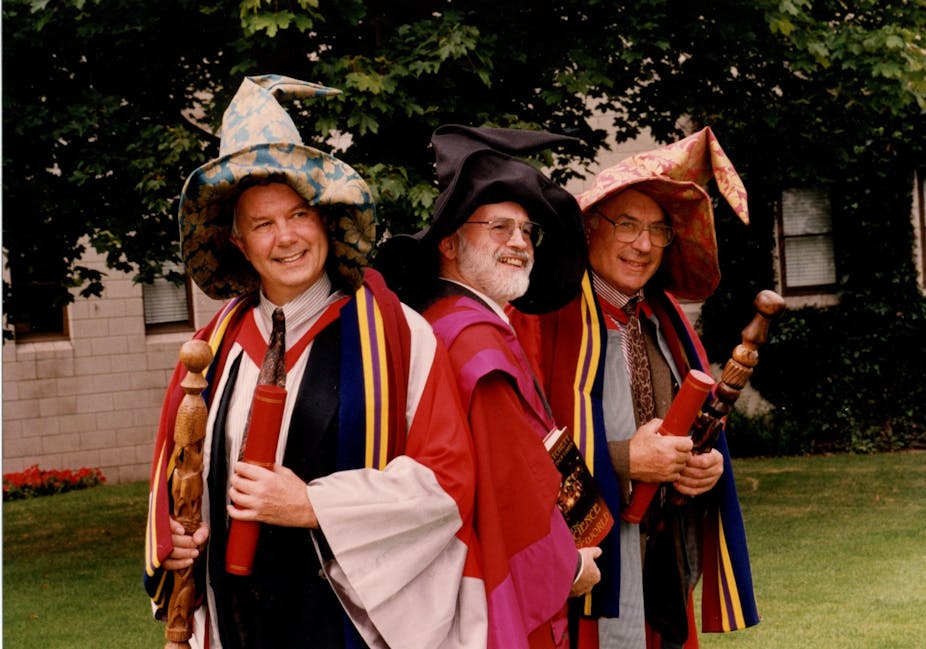One evening, in a Mongolian restaurant, Terry Pratchett, Jack Cohen and I came up with the idea of a popular science book based on Discworld. We all felt that this would be an attractive way to explain science to non-specialists, and that this was a worthwhile thing to do. Unfortunately, as Terry pointed out in his usual direct manner, Discworld runs on magic. It has no direct relation to science.
Eventually the three of us got round this obstacle: the wizards of Unseen University accidentally create a containment field that keeps magic out. Inside is Roundworld, our planet/universe, and it runs on science. From the point of view of Discworld, things we take for granted start to look very strange. The result of this comparing and contrasting was The Science of Discworld, which became a series of four books that we wrote with Terry.
So here are five examples of what Discworld can teach us about science.
Round worlds
Discworld is flat, carried by four elephants standing on a turtle. This is the sensible way to make a world: it’s shaped the way it appears to be, something stops it falling, and it is self-propelled. Roundworld is a silly shape for living on, things ought to fall off, and it swims through space unsupported, which is surprising for a large rock.
The science that explains why round – but a bit flattened – is a sensible shape for a world includes gravity, momentum, and the behaviour of rotating liquids. There’s also the psychology of why we think our senses convey a complete view of reality, rather than a limited and transformed one.

Chaos butterfly
In the 17th Discworld novel, Interesting Times, Terry investigates the workings of chaos, including aspects of “chaos theory”, the mathematical discovery that deterministic laws can have apparently random effects. He gives the famous quantum weather butterfly a cameo role as Papilio tempestae. It flaps its wings … and freak gales cause road chaos.
This alludes to the famous “butterfly effect” in chaos theory, where the flap of a butterfly’s wing can change the weather to something totally different. His suggested solution is “finding that bloody butterfly … and getting it to stop”.
Weather forecasters find it more effective to simulate the weather many times with slightly different random perturbations, in effect trying to find out which butterfly wins. Of course butterflies don’t cause hurricanes – but they affect where and when they occur, all else being equal.
Cat in a box
The witch Nanny Ogg’s cat Greebo is a recurring character of the books. He is tough and streetwise, though Nanny considers him a big softie. When Greebo gets shut in a box in Lords and Ladies, Terry tells us there are three states for a cat in a box: alive, dead, and absolutely bloody furious.
This is an allusion to Schrödinger’s cat, the famous thought experiment in which a cat in a box that you cannot see into is simultaneously both alive and dead because of quantum mechanics … that is, until you open the box and find out which.
Terry’s joke puts quantum observations in a new light. For starters, “alive” and “dead” are not the only alternatives, even in classical physics.
God of evolution
Discworld has a god for almost everything, from Flatulus, god of the winds, to Bilious, the “Oh God of Hangovers”. In particular it has a god of evolution, which puts the science/religion debate in a typically Pratchettian light.
In The Science of Discworld III: Darwin’s Watch the Reverend Charles Darwin writes Theology of Species instead of The Origin of Species. The result? Roundworld stagnates.
While getting it back on track in time to avoid an inbound comet, the wizards introduce Darwin to the god of evolution. Darwin particularly admires the wheels on his elephant. This encounter opens up the entire topic of evolution and why creationist objections are nonsense.
Ate by eight
On Discworld, the number eight is special: the number of magic. There is an eighth magical colour, octarine. The eight son of an eighth son has to become a wizard – even when the midwife gets the sex wrong. No one dares mention the number by name because of the evil god Bel-Shamharoth: you might get ate, OK?
In Roundworld, the number eight is also key, but for a different reason: it plays a key role in atomic structure. Electrons surround the nucleus in concentric shells (energy levels). In principle successive shells can contain up to 2, 8, 18, 32, 50, and 72 electrons, but in practice they tend to fill up when they have eight electrons. The number of electrons in the outer shell determines the atom’s chemical properties. Noble gases have eight outer electrons (only two for Helium since it fills only the first shell) and seldom combine with other elements. So it is a magic number, in a way.
It has been a privilege and an honour to be part of Terry’s Discworld universe, and it is typical of his generosity that he allowed us to do so. And so we mourn his passing, while celebrating his achievements.

